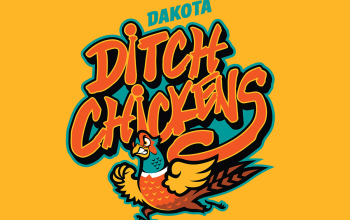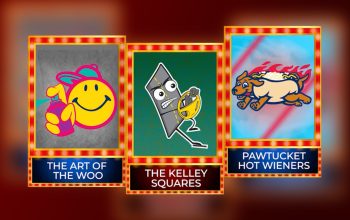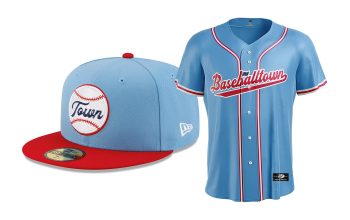This is an objective, scientifically proven fact: Lemurs are awesome. Also, people love lemurs. It’s science.
Here’s another scientific fact for you: Laredo, Texas, is not close to the island nation of Madagascar, which is located in the Indian Ocean and is the only place in the world where lemurs live in the wild.
So when a new team in baseball’s independent American Association opened its doors in Laredo, Texas, in 2012, the fact that it was called the Lemurs might have seemed like a stretch. Team leaders, including owner Mark Schuster and manager Pete Incaviglia, had three criteria for deciding on the new nickname: It had to be kid-friendly, it had to be unique in all of sports, and it had to have a tie to the history of Laredo.
 That third item might have been a sticking point in calling the team Lemurs were it not for some digging (as it were) by the team. I spoke with Lemur manager, longtime Major Leaguer Pete Incaviglia (pictured here in his home Lemur whites), who credits Schuster with discovering the rationale for the name. “Mark did a real good job of going through the history of the lemur,” Incaviglia said. “Way back when, in the dinosaur era, I guess there were a bunch of lemurs that lived in Laredo.”
That third item might have been a sticking point in calling the team Lemurs were it not for some digging (as it were) by the team. I spoke with Lemur manager, longtime Major Leaguer Pete Incaviglia (pictured here in his home Lemur whites), who credits Schuster with discovering the rationale for the name. “Mark did a real good job of going through the history of the lemur,” Incaviglia said. “Way back when, in the dinosaur era, I guess there were a bunch of lemurs that lived in Laredo.”
In researching the area, Schuster had discovered the work of Dr. James Westgate of Lamar University.
“We have one lake in Laredo, and it’s Lake Casa Blanca,” Schuster said. “And this archeological dig was at Lake Casa Blanca, and he found all of these lemur-like creatures—bones, stuff like that, that had been fossilized—in the area.”
The mural above from Lake Casa Blanca International State Park by A. Salazar depicts the area 42 million years ago. Check out the little guy in the tree on the left. Your Laredo Lemurs, ladies and gentlemen!
“While they weren’t specifically the lemurs that we know today—they have evolved over time—these were lemur-like creatures,” Schuster said. (Note: Curt Schilling could not be reached for comment on this point.)
As for appealing to children, Incaviglia put it succinctly: “All kids love a lemur.”
In fact, the choice of Lemurs as a mascot means that the team has pop culture doing a lot of their marketing for them. “We all know the movie Madagascar and King Julien, ‘We’ve got to move it, move it!'” Schuster said. “I thought, we have a 20-year lease at the stadium, these kids grew up watching Madagascar—and there’s going to be Madagascar 19, 20, 21—they’re going to keep making them from here until forever.” (My own kids also loved PBS’s Zoboomafoo, which features a talking lemur.)
While people do love lemurs, the team name itself was not well received when it was first announced—which seems to be par for the course with unique minor league team names. Schuster knew the backlash was coming, and even warned city officials to that effect.
“I absolutely took a beating from everybody in the market,” Schuster said. “I met with the city a few days before making the announcement and I said, ‘Listen, I just want to let you know that we’re going to name the team the Lemurs, and I want you to know that the reaction is going to be completely negative, so just be prepared.’”
Knowing that the negative reaction was coming allowed Schuster to use it to his advantage. “It’s an opportunity for me also to get some media attention,” he said. “I was on every TV station, every radio show defending myself as to why we named this team the Lemurs.”
The choice of lemurs as a baseball mascot is a bit unusual, and probably requires some defending. “The animal itself is fat and lazy,” Schuster said. “Lemurs, when they’re sitting around, they sit on their ass and their belly hangs out.”
 I reached out to Chris Smith, education specialist at the Duke Lemur Center, one of the premier lemur research facilities in the world, which has a fun lemur logo of its own. Smith pointed out that the ring-tailed lemur, the species featured in the team’s logo, is well suited to baseball because it’s adaptable, eats almost anything, and lives in large social groups, just like baseball players. The ring-tailed lemur has poor eyesight, though, so another variety of lemur might have worked better. According to Smith, red-ruffed lemurs have an alarm call heard over a half mile away, good for heckling. Aye-ayes have the biggest brain, suitable for coaching. And Coquerel’s sifaka have an eight-foot vertical jump. “You might want those guys snatching those homers from over the wall,” Smith said.
I reached out to Chris Smith, education specialist at the Duke Lemur Center, one of the premier lemur research facilities in the world, which has a fun lemur logo of its own. Smith pointed out that the ring-tailed lemur, the species featured in the team’s logo, is well suited to baseball because it’s adaptable, eats almost anything, and lives in large social groups, just like baseball players. The ring-tailed lemur has poor eyesight, though, so another variety of lemur might have worked better. According to Smith, red-ruffed lemurs have an alarm call heard over a half mile away, good for heckling. Aye-ayes have the biggest brain, suitable for coaching. And Coquerel’s sifaka have an eight-foot vertical jump. “You might want those guys snatching those homers from over the wall,” Smith said.
Smith is glad to see lemurs featured in a baseball logo, but he did have one concern. “The great American game mixed with the most endangered mammal group means that lemurs get a kind of cultural penetration that is difficult to achieve otherwise,” he said. However, “Their graphic designer makes lemurs look so mean!”
Schuster addressed this point in conversations with Jason Klein of Brandiose, the firm that designed the logo.
“Jason and I went back and forth on this about what the animal should convey,” Schuster said. “We thought if we made him happy, jolly, whatever, that it doesn’t convey that we’re competitive and that we’re a team to be reckoned with. And so we went with the opposite of what a lemur really is.”
Alternate versions of the logo feature the lemur carrying a Texas-ish flag, an LL for Laredo Lemurs, and, as described by Brandiose’s Casey White, a “sleeve patch featuring a tiny Lemur digging his claws into the player’s sleeve.”
Schuster wanted to have a live lemur in the ballpark, which fans would see as they attended games, and which could travel to local schools to educate children about the endangered mammal. There was one insurmountable obstacle to that plan, though: “The problem is in Laredo, Texas, we’re about two and a half hours from, you know, American civilization, which is San Antonio,” Schuster said. “You really need to have a veterinarian close by that can work on primates, and that was sort of the obstacle that we were unable to overcome.”
The next best thing to a live lemur in the ballpark is the team’s mascot, Pancho, who was designed by the original Phillie Phanatic, Dave Raymond, and who Schuster says is more popular than the team’s players.
In the end, these logos and mascots have one purpose, which the Lemurs accomplish with gusto. “You know, minor league baseball is fun. Minor league baseball is about family entertainment,” Incaviglia said. “And to have a neat mascot to go with your logo makes people want to come out and enjoy baseball.”
The Lemurs have a solid enough fan base to call “Lemur Nation,” the team sells gear to fans of both Lemurs (the team) and lemurs (the animal) all over the world, and you can be sure that the next Madagascar sequel is right around the corner.

















